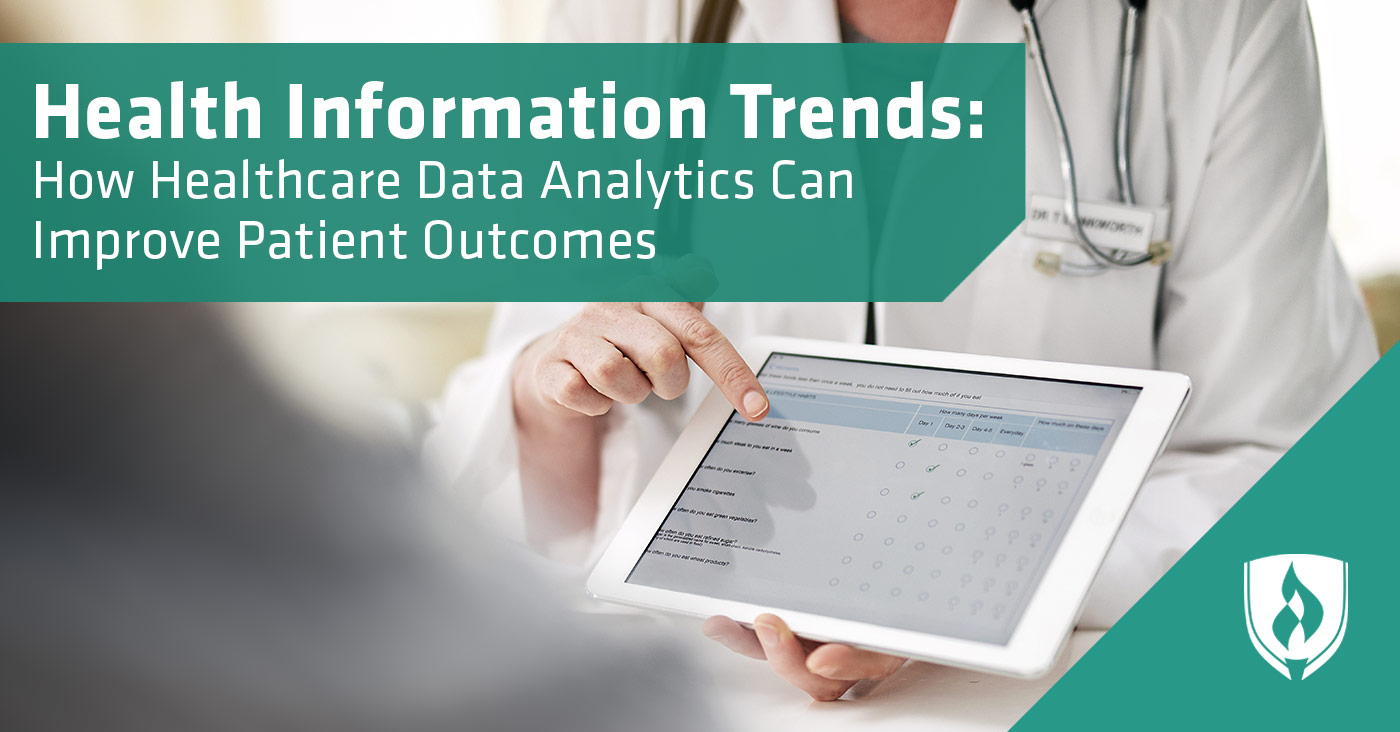Health Information Trends: How Healthcare Data Analytics Can Improve Patient Outcomes
By Brianna Flavin on 03/26/2018

One of the biggest revolutions in modern day healthcare is the wide-scale adoption of electronic health records (EHRs). When hospitals, clinics and healthcare facilities at every level started moving their patient information to digital databases—the entire healthcare horizon changed. In hard-copy form, patient information was difficult to locate, keep organized and keep updated. Now that information is available to patients and their providers with a few clicks.
Suddenly, the huge masses of data healthcare providers work with became available for more than just patient records. “With paper records, many pieces of data were never brought together and organized for analysis—it wasn’t conceivable,” says Denise Van Fleet, MS, RHIA, program coordinator for the Health Information Management program at Rasmussen College.
“But now, a single structured data field that asks, ‘Are you a current smoker? Yes or No,’ allows for the analysis of the impact of smoking on the health of hundreds of patients with the generation of one data pull.”
This is where healthcare data analytics comes in. This field and the professionals within it aim to make good use out of all the data healthcare systems generate. “In today’s healthcare ecosystem, healthcare analytics is incredibly vital to many different components of patient care,” says Meghan Nechrebecki, founder and CEO of Health Care Transformation.
The possibilities for how we use and learn from the data in healthcare are only beginning. Read on to see how healthcare data analytics plays an integral part in steering the future of healthcare.
What is healthcare data analytics exactly?
First, let’s define some terms. Healthcare data analytics is the responsible analysis and use of electronic health data that is captured in computer systems such as EHRs, according to Van Fleet.
“It also speeds up the delivery of healthcare,” says Darnell Morgan, DNP and president of N.U.R.S.E. INC. “Imagine a world without email. We would write letters, put it in the mail and wait for a reply. This process could take up to 30 days.” Morgan explains that the speed and efficiency of email took place for healthcare in the form of EHR systems.
“Once a physician places an order, it is immediately made available to the staff. Once the order is processed, the results are then received electronically. If this were a pen and paper process it would take us longer to diagnose and treat a patient,” Morgan says. “And in the world of medicine, timing is everything.”
“Healthcare data and analytics entails aggregating, processing, maintaining and, ultimately, developing meaningful measures that can be analyzed and utilized in order to improve patient care,” Nechrebecki says. The field of healthcare data analytics is massive and how its findings are applied will vary depending on the organization.
Healthcare data analytics in a health insurance company looks different from the same process happening in a hospital. “Health insurance companies use data analytics to manage costs of their member populations using claims, or what we call administrative or billing data,” Nechrebecki says.
In comparison, a healthcare provider such as a hospital uses data to ensure a high quality of care for their patients. “They also use it to create real-time decision support tools in the electronic medical records and to develop population health interventions that engage patients,” Nechrebecki adds.
“Understanding your health data allows medical practitioners to educate themselves prior to making treatment changes or medical equipment purchases,” Van Fleet says, adding that even facility expansion projects can be directed by careful data analytics.
On a different front, healthcare providers can also use healthcare analytics to publish research and share best practices. Doing so supports the financial health of those institutions while also sharing important findings and information to improve care, according to Nechrebecki.
Who works in healthcare analytics?
You might see job titles like healthcare data analyst, database management, healthcare claims data analyst and healthcare administrator, according to healthcare informatics consultant Jean De Vasconcelos.
Nechrebecki says jobs in healthcare analytics also typically include project managers, analysts, advisors, consultants and specialists. “The company may spice up these titles depending on the specific area of healthcare analytics the position would be in.”
Another branch of healthcare analytics comes from the medical provider side—clinical informatics. “Clinical informatics is the science of incorporating your experience and skills as a member of the healthcare team with skills in IT to create, design, build, implement, analyze and support EHRs, such as EPIC, Cerner, Nextgen, Meditech and Allscripts,” Morgan says.
“I started off as a ‘superuser,’” Morgan explains. Superusers (sometimes called testers or trainers) are non-IT personnel, like nurses or medical assistants who help with support and troubleshooting to other EHR users in their areas. “As a superuser, I learned all aspects of the system and began training classes for new nurses and providers, assisting during system upgrades and providing ‘at-the-elbow’ support for new clinics,” Morgan says. “This led me to become part of the clinical informatics team.”
What does the future of healthcare analytics look like?
The federal government is making an effort to shift federal insurance programs away from fee-for-service payment models and toward value-based payments.
“As is almost always the case, federal insurers (Medicare and Medicaid) move the bar and the healthcare industry strives to meet the challenge.” Van Fleet explains that this call to tie quality of care to reimbursement will definitely motivate healthcare providers like hospitals and clinics to understand their quality measurements and how their care measures up for value.
“This understanding can only be accomplished through directed analysis and timely responsiveness to facility data,” Van Fleet says. “This is the foundation and driving force of healthcare data analytics.”
This integration of claims data with EHR data is also a thrilling development for Nechrebecki. “This combination gives you a more holistic view of the patient, and one can analyze patient healthcare costs and health outcomes together.”
“In today’s world there are so many trends that are helping move innovation in healthcare,” Vasconcelos says. “Healthcare facilities can do so much more when they analyze information they gather from their patients.”
Making a difference with data
Data is changing our society on many levels. But in healthcare, gleaning useful information means higher quality of care, lower costs, better decision-making and new discoveries that can save lives.
If healthcare data analytics piques your curiosity, you should definitely keep an eye on the industry of health information technology (HIT) where exciting changes are happening all the time.
Related Articles:




